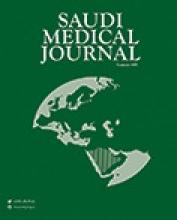Abstract
OBJECTIVE: To determine the clinical characteristics, risk factors, causative organisms and antimicrobial susceptibility in diabetics and non-diabetics admitted to King Abdulaziz University Hospital Medical Unit to decide on the use of empiric antimicrobial therapy.
METHODS: Significant bacteriuria from the Medical Unit of King Abdulaziz University Hospital from January 1999 to August 1999 were included in the study. Medical records were reviewed and the patients were divided into 2 groups according to the presence or absence of diabetes. The following information was recorded, patients' age, sex, type of infection (community or hospital acquired), presence of dysuria, urinary catheter, intensive care unit admission, duration of hospital stay, type of organism isolated and their antimicrobial susceptibility.
RESULTS: A total of 182 specimens were studied, 58 (32%) were diabetics. Mean age of diabetics was 64 years versus 54 years in non-diabetics and the male:female ratio was 1:1.6 versus 1:1.1 (p0.001, 0.03). Urinary catheters were present in 12/58 (20%) diabetics and 31/124 (25%) non-diabetics, intensive care unit admission was in 23/58 (40%) versus 38/124 (31%), and duration of hospital stay was 43 days versus 38 days (p0.6, 0.1, 0.4). Escherichia coli was isolated in 9/50 (18%) hospital acquired infections and 4/8 (50%) community acquired infections in diabetics versus 26/106 (25%) and 8/18 (47%) in non diabetics. Pseudomonas species were isolated in 16/50 (32%) and 1/8 (13%) in diabetics and 22/106 (21%) and 0/18 in non-diabetics. Escherichia coli and pseudomonas in both groups showed resistance to ampicillin and sensitivity to aminoglycoside and ciprofloxacin.
CONCLUSION: Diabetics were older with high female ratio compared to non-diabetics. Escherichia coli is the most common isolate in community and hospital acquired infections in non-diabetics, while Escherichia coli was common in community acquired infection and pseudomonas was the predominant isolate in hospital acquired infection in diabetics. Aminoglycoside and ciprofloxacin can be used empirically to treat both types of infection in diabetics and non-diabetics.
- Copyright: © Saudi Medical Journal
This is an open-access article distributed under the terms of the Creative Commons Attribution-Noncommercial-Share Alike 3.0 Unported, which permits unrestricted use, distribution, and reproduction in any medium, provided the original work is properly cited.






